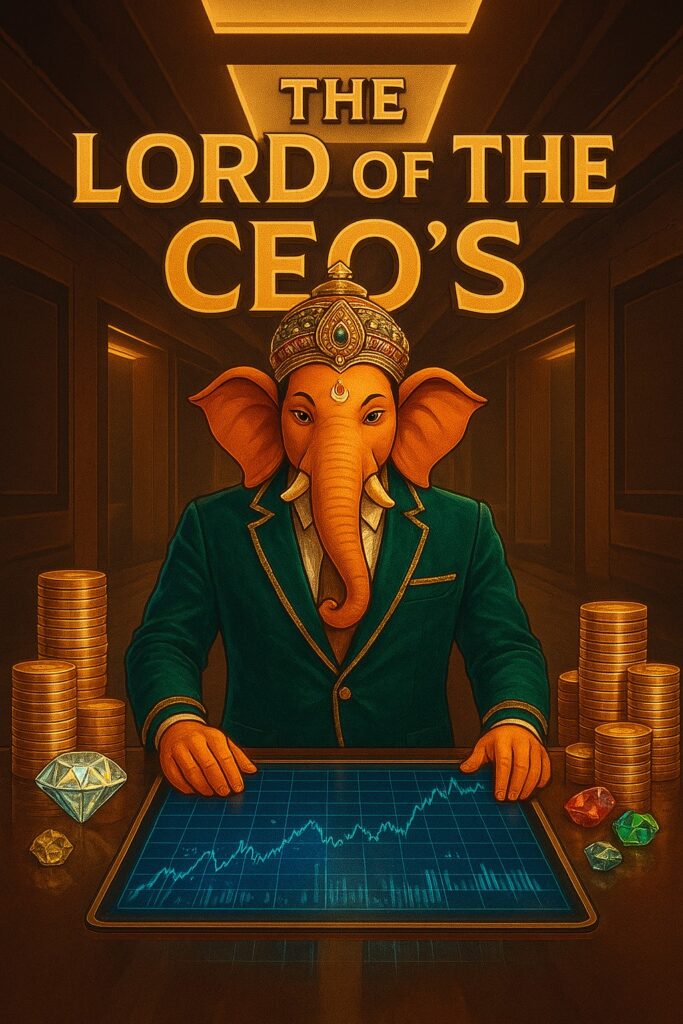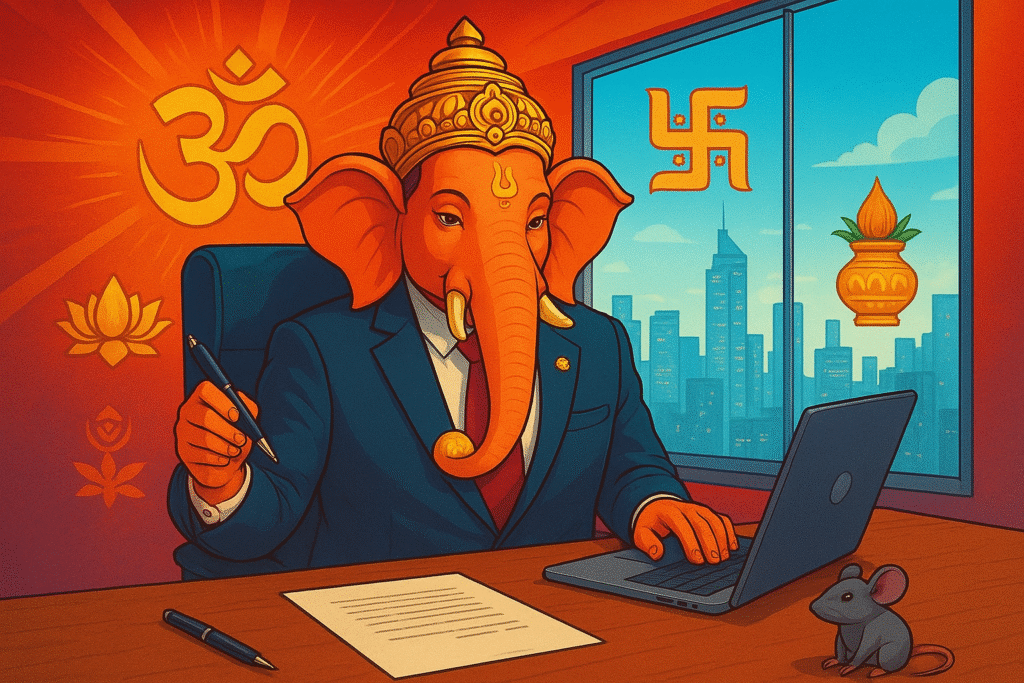While modern CEOs crash and burn quarterly, one ancient leadership framework has maintained perfect performance for over a Million years. No failed ventures, no hostile takeovers, no scandals. This elephant-headed executive’s management principles are finally being decoded by Silicon Valley’s smartest minds.

In the cut-throat world of corporate leadership, where Fortune 500 CEOs rise and fall like stock prices, one executive stands undefeated. He’s never missed a quarterly target, never faced a hostile takeover, and has maintained consistent growth for over 5,000 years. His name? Lord Ganesha, and his boardroom is the entire universe.
While modern leaders scramble for the latest management fad, Ganesha’s track record speaks for itself. The Rigveda (2.23.1) introduces him with the ultimate executive profile:
“गणानां त्वा गणपतिं हवामहे कविं कवीनामुपमश्रवस्तमम्“
“We invoke You, O Gaṇapati, the leader of all beings, the seer among seers, most famous of all.”
This isn’t just ancient poetry, it’s a performance review that any modern CEO would kill for. The title “Kavi of Kavis” (seer among seers) translates to what we’d call today: visionary leadership with predictive analytics capabilities.
The Original Triple-Bottom-Line Leader
The Ganapati Upanishad reveals Ganesha’s comprehensive business model:
“त्वमेव केवलं कर्ताऽसि। त्वमेव केवलं धर्ताऽसि। त्वमेव केवलं हर्ताऽसि।“
“You alone are the creator. You alone are the sustainer. You alone are the destroyer.”
In modern corporate terms, this is the complete business cycle: innovation and R&D (creation), operational excellence (sustenance), and strategic disruption when necessary (transformation). Most CEOs struggle with one of these aspects, Ganesha mastered all three before business schools even existed.
Emotional Intelligence Before It Was Cool: The Elephant Advantage
Long before Daniel Goleman coined “emotional intelligence,” Ganesha was demonstrating why EQ trumps IQ in leadership. His elephant head isn’t just divine symbolism; it’s a masterclass in cognitive superiority.
Neuroscientists confirm that elephant brains are remarkably sophisticated, with complex neural networks supporting emotional intelligence, long-term memory, and social cooperation. They demonstrate grief, humor, compassion, cooperation, self-awareness, and excellent learning abilities. In essence, the elephant head represents the ultimate emotional intelligence, something modern leaders spend fortunes trying to develop.
“The mighty head inspires expansive vision,” observes contemporary business leader Jashan Bhumkar. This isn’t metaphorical fluff, it’s practical wisdom. While human executives get trapped in quarterly thinking, the elephant consciousness operates with long-term perspective and emotional stability.
Consider this: When was the last time you saw an emotionally unstable elephant leading a herd? Exactly. Ganesha’s elephant head symbolizes the kind of calm, emotionally intelligent leadership that builds sustainable organizations rather than quarterly flash-in-the-pan successes.

The Strategic Communication Advantage
While modern executives drown in Slack messages and endless meetings, Ganesha demonstrates the power of strategic communication through his physical design:
Large Ears, Small Mouth: His big ears represent deep listening, something studies show is the most underrated leadership skill. “Leaders often get the best results when they stop talking and start listening,” confirms research on executive effectiveness.
His small mouth embodies the principle: “Speak Less and Listen More.” In our age of social media oversharing and constant communication, this ancient wisdom becomes revolutionary. The most successful leaders today aren’t those who tweet the most, but those who listen most deeply to market signals, employee feedback, and customer needs.
The Broken Tusk Strategy: Sacrifice for Success
Ganesha’s single tusk (Ekadanta) tells the ultimate leadership story. When his pen broke while writing the Mahabharata, he broke his own tusk to continue the work. This isn’t just mythological drama, it’s the defining characteristic of transformational leadership.
Modern translation: Sometimes personal comfort must yield to organizational mission. Jeff Bezos sleeping on a desk in Amazon’s early days, Elon Musk sleeping in the Tesla factory during production hell, these are contemporary applications of the Ekadanta principle.
The Strategic Masterpiece: Redefining Competition
Perhaps Ganesha’s most brilliant business case study comes from the famous race around the universe. When challenged to compete with his brother Kartikeya, Ganesha faced a resource constraint: his vehicle was a tiny mouse compared to his brother’s peacock.
Instead of accepting disadvantage, Ganesha redefined the game. He circled his parents three times and declared victory, reasoning that they embodied the entire universe. The result? He won by changing the rules rather than playing by them.
This strategy appears in every successful disruptive business:
- Resource Optimization: Work creatively within constraints
- Problem Reframing: Don’t accept conventional definitions
- Core Value Focus: Understand what really matters to stakeholders
Netflix didn’t compete with Blockbuster on their terms—they redefined what video rental meant. Uber didn’t compete with taxis—they redefined transportation. This is pure Ganesha strategy in action.
The Humble Leadership Model
Ganesha’s mouse vehicle represents perhaps the most counterintuitive leadership principle: true power comes from humility. The mouse symbolizes doubt and over-analysis, which Ganesha controls by riding atop it. A strategic leader must not let logic have a free rein while maintaining control over analytical paralysis.
“The mouse is the tiniest creature and is used as a vehicle by Lord Ganesha. It indicates that a small thing can be very useful and advantageous for us,” reveals ancient wisdom that modern leaders ignore at their peril. The most successful executives often succeed not despite humble beginnings, but because of them.
Crisis Management: The Calm Leader Advantage
Contemporary research on leadership effectiveness consistently shows that calm leaders outperform reactive ones. Ganesha embodies this principle: “All of us are in such a hurry to prove that we are always right, that we use our might before actually analyzing the true situation. In most cases, anger leads to disappointments rather than quicker success. Being calm and level-headed are the stepping stones to corporate success.”
In our era of Twitter meltdowns and public CEO outbursts, this Million year-old wisdom seems almost prophetic.

The Obstacle-to-Opportunity Algorithm
As “Vighnaharta” (obstacle remover), Ganesha doesn’t just solve problem she transforms them into competitive advantages. “In business, you will face numerous challenges and hurdles. The lesson here is to approach obstacles with determination, creativity, and adaptability. Just as Ganesha found innovative solutions to overcome his obstacles, entrepreneurs should find ways to navigate challenges and keep moving forward.”
This isn’t positive thinking, it’s strategic thinking. Every successful business has turned its biggest obstacle into its greatest strength. Amazon turned book distribution challenges into the world’s largest logistics network. Tesla turned automotive industry resistance into a direct-to-consumer advantage.
The Integrity Imperative
Perhaps Ganesha’s most relevant lesson for modern leaders comes from the Shiva Purana. When Lord Shiva created a rule that Ganesha must be worshipped first but then forgot to follow his own rule, consequences followed immediately. “Being a leader you must lead by example. There can never be separate rules for two different classes.”
In an era of corporate scandals and leadership failures, this principle becomes absolutely critical. The most successful long-term leaders are those who hold themselves to the highest standards.
The Timeless Success Formula
“From artisans to entrepreneurs, students to sustainability advocates, one truth stands out: Ganpati Bappa is more than a festive figure. He is a teacher. He reminds us to be patient when we want quick results, resilient when we face setbacks, humble when success arrives, and responsible when the world needs us most.”
While Harvard MBAs and Stanford graduates compete with quarterly metrics, Ganesha’s wisdom offers something more valuable: sustainable, ethical, and ultimately more successful leadership principles that have worked for millennia.
In boardrooms filled with the latest management theories, perhaps it’s time to rediscover this ancient CEO who never needed a turnaround consultant, never faced a board revolt, and whose leadership principles are still generating results thousands of years later.
The question isn’t whether ancient wisdom can compete with modern management, it’s whether modern management can live up to ancient standards. Rest as the wise say, when in doubt; ” Leave it to his wisdom”


